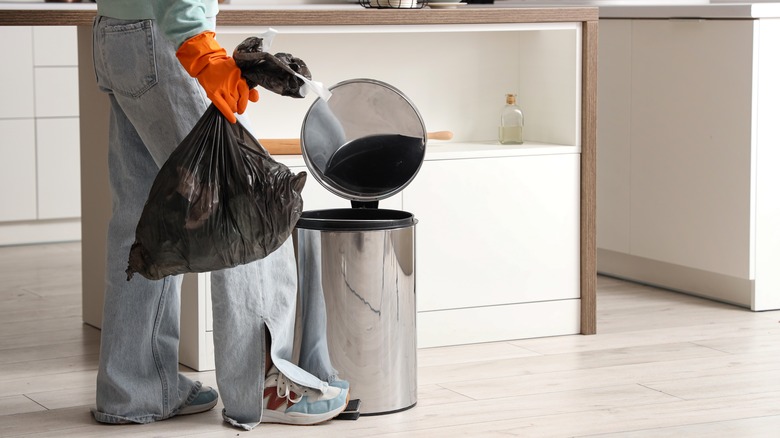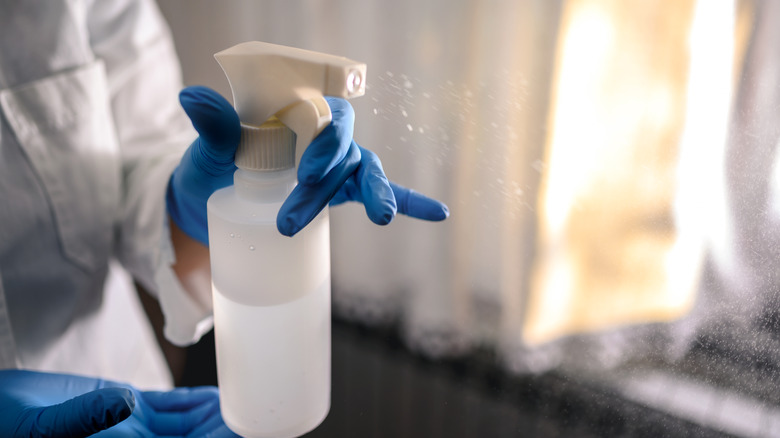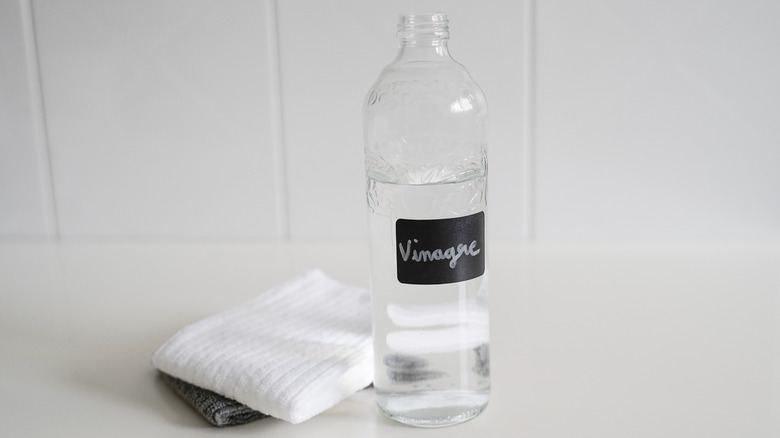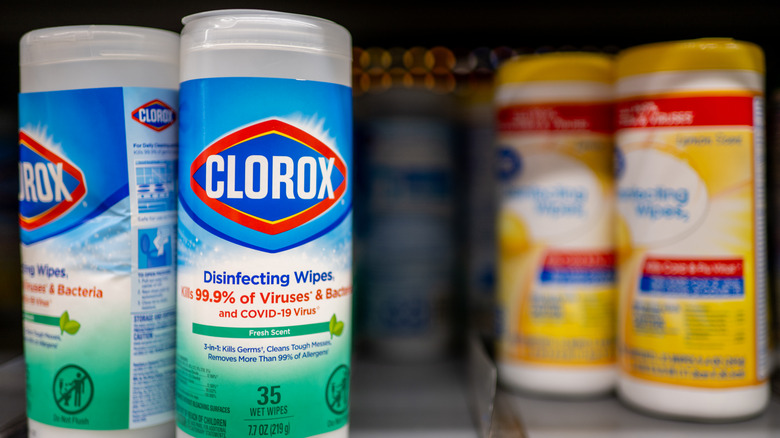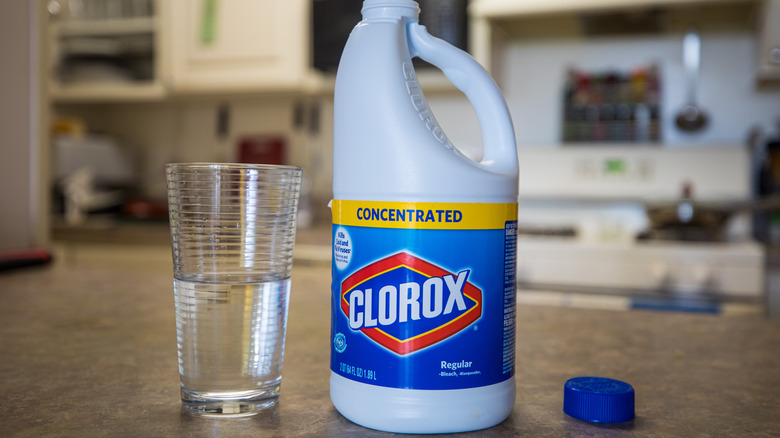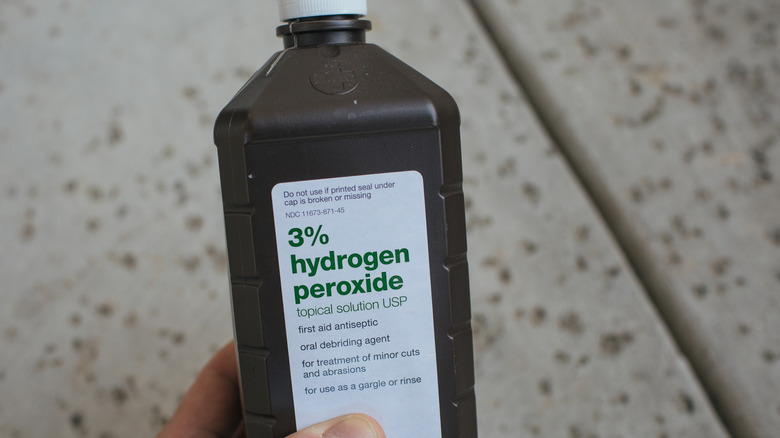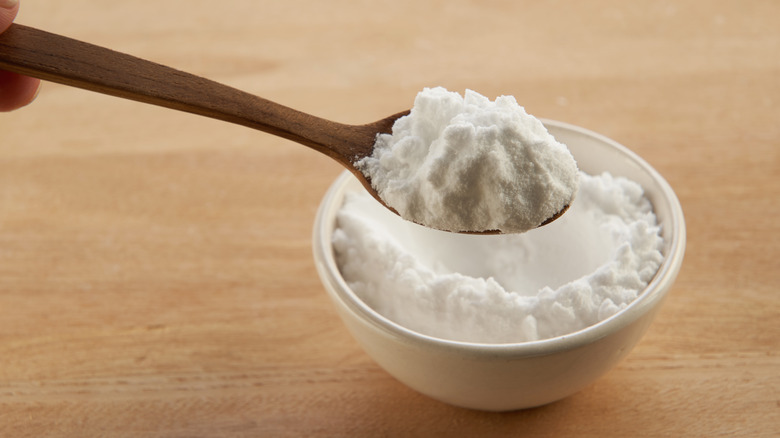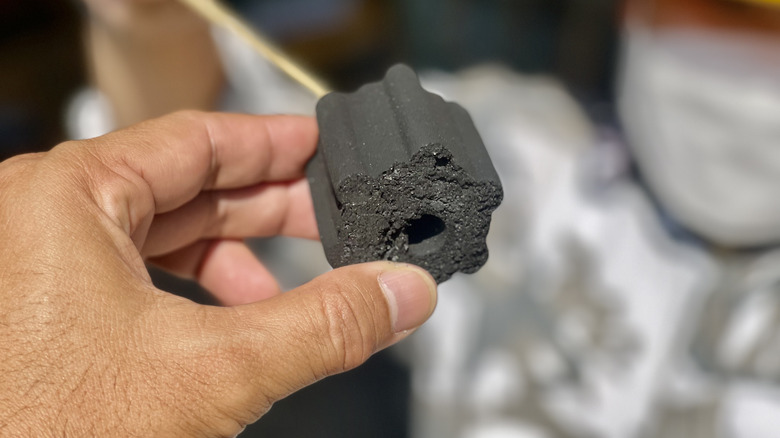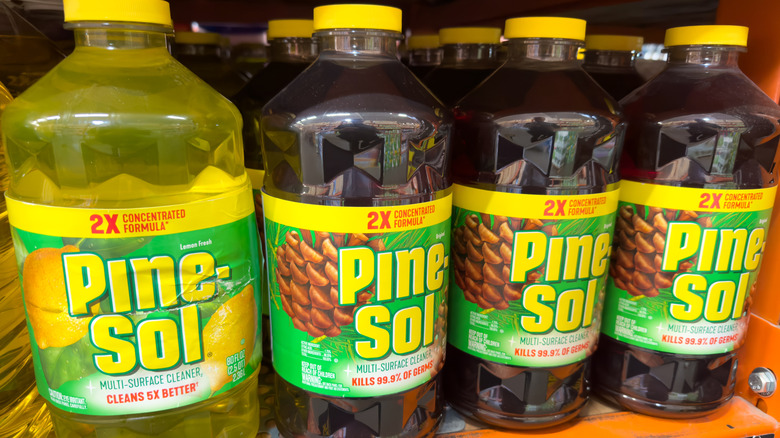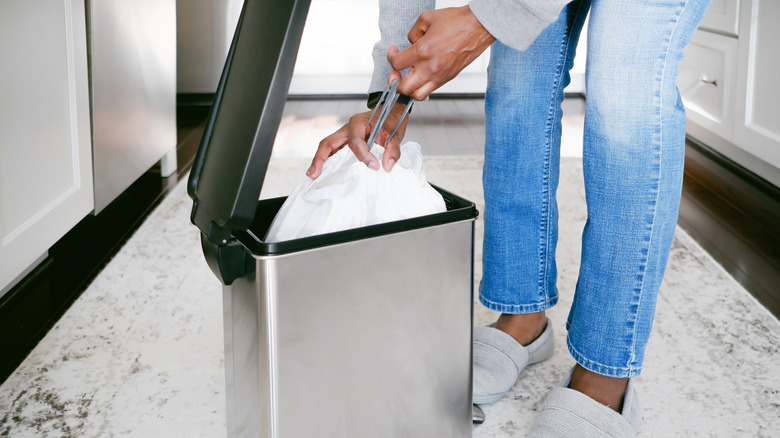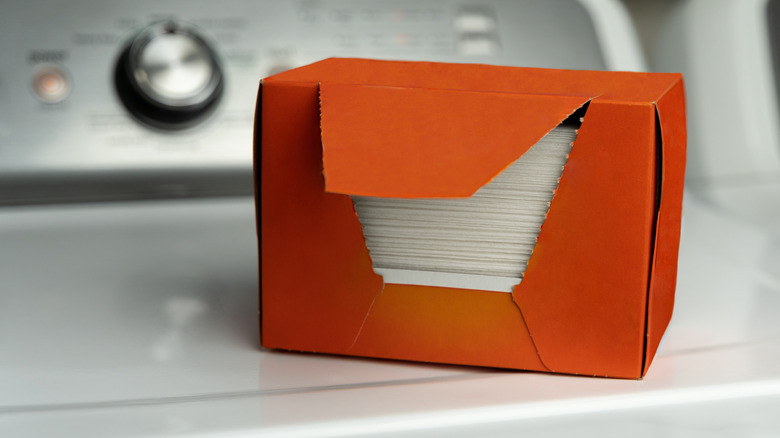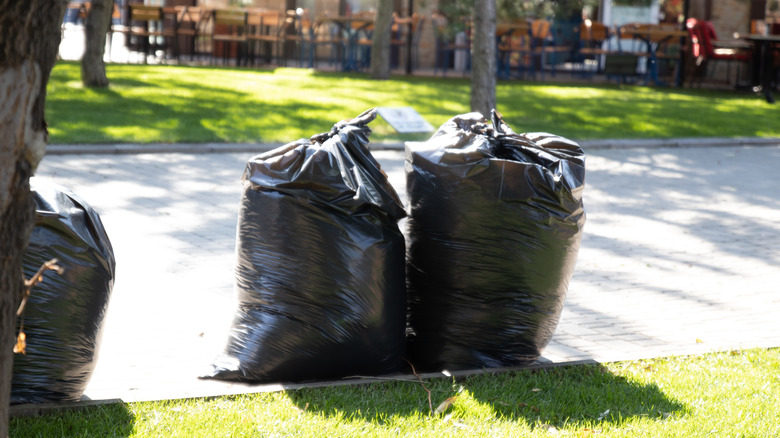The 11 Best Ways To Clean & Deodorize Your Trash Can To Combat Funky Smells
We may receive a commission on purchases made from links.
When considering what to clean in your kitchen, sticky stove tops, splattered microwaves, and grimy sinks often take precedence. Not many people think to scrub out their kitchen trash cans, especially if they're hidden out of view in a pull-out drawer or a cabinet under the sink. However, neglect can lead to a build-up of dirt and garbage smudges, making it unappealing to look at and resulting in an unpleasant odor. Luckily, there are plenty of easy and effective ways to clean and deodorize your can.
Whether you're a fan of tried-and-tested cleaners like bleach or prefer eco-friendly options like vinegar, there's a cleaning method for everyone. Each of these methods not only cleans the bin, removing any embarrassing smudges or drips from sight, but also tackles the bacteria that cause unpleasant odors. From a simple cleaning solution that utilizes soap to odor-fighting TikTok hacks, there's something for everyone. Keep reading for a range of proven ways to clean and deodorize your kitchen garbage can.
Deep clean it monthly with soap or cleaner to keep smells at bay
The easiest way to keep your garbage can smelling fresh is to routinely clean it with either dish soap or an all-purpose cleaner. By making this a regular part of your monthly maintenance, you'll avoid the need for drastic measures to deodorize or degrime a smelly can that hasn't been cleaned in a year. Plus, it will make the task less unpleasant since you're not waiting until the can is filthy to tackle it. If you clean your garbage can often, you will also stay on top of disinfecting it. This will keep harmful bacteria at bay, like salmonella and E. Coli.
Making this task part of your monthly routine is easy. All you will need is rubber gloves, dish soap or an all-purpose cleaner, a sponge or new toilet bowl brush, and paper towels or an old towel. If your can isn't too dirty, you can get away with cleaning it with the cleaning spray. Simply spray down the outside and inside of the can, and use a paper towel to wipe it clean. If it's a little grimier this month — whether because some garbage leaked into the can or you had a particularly smelly bag — then give it a more thorough scrubbing with dish soap. If you have a backyard, bring the can outside and rinse it with a garden hose. Fill it with water and put soap in it, allowing it to soak for five to 10 minutes. Then, scrub it clean with a sponge or new toilet brush, depending on how deep it is. If you can't clean it outside, follow these steps in your tub. Make sure to clean and disinfect your tub afterward.
Use vinegar to kill odor-causing bacteria
If your trash can smells particularly odorous this month, then swap out your all-purpose cleaner for something with a little more bacteria-fighting power, such as vinegar. Distilled white vinegar not only cleans grime, but helps kill all sorts of harmful bacteria. This makes it a great clean alternative to bleach, and can help nix rancid smells from your trash can since bacteria is causing the odor. However, for vinegar to be effective at disinfecting, it needs to be heated up.
Heat 1/2 cup of vinegar in a pot or pan on the stove to 150 degrees Fahrenheit. Immediately transfer it into a spray bottle and spray down the inside and outside of your can with it. Allow it to sit for a minimum of one minute in order to effectively kill the bacteria, and then wipe it clean. If you can't heat the vinegar, then you can use it at room temperature, but the chore will take a bit longer. You need to allow room temperature vinegar to sit on the surface for a minimum of 10 minutes for it to kill bacteria. Once that time is up, wipe the can dry. If you're dealing with a particularly odorous trash can, switch your spray bottle for a bucket. Mix 1/2 cup of vinegar with 1 gallon of hot water in the can and allow it to soak for an hour. This will target the bottom of the bin, which is usually the stinkiest part. Rinse it clean, and allow the can to air dry. This should deodorize it, and the vinegar smell will dissipate after a day or so.
Use an antibacterial cleaner as a shortcut
If you would prefer not to mess around with warming your cleaning sprays, then you can use an antibacterial wipe or spray as a shortcut. While this will be just as effective, the possible downside to this is that it isn't a "green" cleaning product. However, if you're not exclusively trying to use natural cleaning ingredients in your home, then this is an easy alternative. You can use products like Lysol Disinfecting Wipes to quickly wipe down the outside of the can or wipe away any spills inside. Then, with a new wipe, quickly disinfect the inside of the can before you add your garbage bag. However, if your can is grimy and you need a more thorough clean, try using Lysol Kitchen Pro Antibacterial Cleaner, which is an all-purpose spray.
In order to properly sanitize and disinfect the can with the disinfecting wipes, you need to allow the liquid to stay on the can for a specific amount of time. To sanitize, the surface has to remain wet for 10 seconds, but to disinfect, it needs to stay wet for three minutes. To ensure it stays visibly wet for that long, first make sure to douse the surface with enough disinfectant, and then reapply it when it begins to dry before the allotted time is up. Once 10 seconds or three minutes is up, you can either wipe it clean or allow it to air dry. As for the antibacterial cleaner, it will not only degrime your can, but also kill 99.9% of bacteria and viruses, including E. Coli and salmonella. However, you need to leave it for 30 seconds to sanitize, and five minutes to disinfect.
Use bleach for a thorough clean
If your trash can feels extra odorous and grimy, it might be more efficient to bring out the big guns. To quickly kill bacteria and bring your can back into tip-top shape, consider washing it with bleach. However, there are things to keep in mind in order to use it safely and effectively. First and foremost, never mix bleach with other cleaners like ammonia or vinegar since the former can create chloramine gas, and the latter can make chlorine gas. Both are hazardous to your health and can cause serious respiratory issues. Prior to mixing it with any solution, double check that it is safe to do so. Secondly, to ensure you have a potent enough mixture to kill germs but not so potent that it damages your trash can or lungs, create a ratio of 1:32 of bleach to water.
This translates to 1/3 cup of bleach to 1 gallon of water, or 1 milliliter of bleach (which is just a little over 1 tablespoon) to a 32-ounce spray bottle. Adding less might make it ineffective at sanitizing while adding more can irritate your lungs. If you would like to clean your can with a bucket, add 1 gallon of the bleach and water mixture to your bin and allow it to sit for 10 minutes. This is how much time you need for the bleach to effectively wipe away odor-causing bacteria. Then, pour out your solution, wipe the inside of the can with a damp paper towel to remove any bleach residue, and then wipe it dry. If you prefer to go the spray route, douse the can and allow it to sit for 10 minutes. If it dries before then, reapply the mixture. Wipe it clean, and then remove the leftover residue with a clean, damp rag.
Use hydrogen peroxide to disinfect
Another way you can disinfect your trash can and remove odor-causing bacteria is to use hydrogen peroxide. However, while you can clean the garbage can with vinegar, anti-bacterial cleaner, or bleach, you can't clean it with hydrogen peroxide. That's because it won't be efficient at lifting away dirt and grime. Instead, wash your can with soap or a multi-purpose spray, and then use hydrogen peroxide to disinfect it. This is a great option if you don't have any of the other options on hand, or if you're looking for an easy, green, and odorless way to disinfect the bin. The way hydrogen peroxide destroys bacteria is by breaking down into water and oxygen when it comes into contact with bacteria. The oxygen molecule is super reactive, and it damages the bacteria's cell walls and proteins, effectively destroying it. This helps to wipe away the smell.
To use it, use 3% hydrogen peroxide, which is medical-grade. There is also 35% hydrogen peroxide, but that is too potent for a simple chore such as disinfecting a can, and it can be toxic if you inhale it or get it on your skin. So, in this case, stronger isn't better. To use it, create a 1:1 ratio of peroxide and water in a spray bottle and leave it on the can's surface for five minutes. If it evaporates before five minutes is up, reapply it. Then, allow it to either air dry or wipe it dry.
Use baking soda to deodorize it
If your trash can is clean but it has a stubbornly funky smell, then you need to focus on deodorizing it. While using bleach or similar disinfectants will nix any bad smells, there are other methods you can take if you prefer to clean with a multi-purpose spray or soap and are left with a stink. One of the best ways to do that is to utilize baking soda. The powder is a base, and when it comes into contact with an acidic odor, the two molecules cause a reaction and become neutral. Since they are no longer volatile, they don't have a smell.
You can do two things to deodorize your bin with baking soda. The first is to deodorize your physical garbage can with it. After cleaning it with your choice of spray, sprinkle 1/2 cup of baking soda in the can, coating the bottom. Allow it to sit for 10 minutes, and then rinse it out. However, if it's especially smelly, move on to option two, which is to create a baking soda rinse of 1 cup of baking soda to 1 gallon of water. Either pour the entire gallon into the can or liberally spray the entire receptacle. This will help deodorize the sides. Allow it to sit for 10 minutes, and then rinse clean. This should remove any stench. Alternatively, when throwing out trash into your bin, add a healthy sprinkling of baking soda between layers of trash, especially if you have a taller can that doesn't get taken out as often. This will help keep the smells under control.
Use activated charcoal if baking soda fails
For super persistent smells that permeated into the porous plastic, consider using activated charcoal to neutralize the smell. Some believe this is more effective than baking soda at eliminating odors and is often suggested if baking soda fails. It's so strong that it can even tackle smoke smells lingering after a house fire. It works so well because it is extremely porous, and those pores increase its surface area, providing loads of extra room for odor molecules to adhere to. Once they do, the carbon traps the acidic molecules, removing them from the air and making it appear less stinky.
There are several ways you can use this to nix any lingering garbage smells. The first is to deodorize the can. To do so, spread the charcoal on the bottom of the canand put a lid or cover on top to trap the odor inside. Leave it for two to three days, which will put your can out of commission for a bit. However, this should soak up any remaining odors, leaving a fresh bin. If you don't want to find a new receptacle to store your trash in for a few days, then another way you can do this is by hanging activated charcoal sachets inside the bin, between the can and the garbage bag. You can leave this in the can as part of your weekly deodorizing routine, changing it out every time you take out the trash and put in a new bag. Not sure where to buy these sachets? Try the ones from Vergali Store, which cost $17 for 10 on Amazon.
Use Pine-Sol to give it a fresh scent
If you plan to use an anti-bacterial spray to clean your trash can, consider using Pine-Sol since it can both sanitize and perfume your bin. It not only kills 99.9% of germs, including COVID-19, but it's also a powerful cleaner, lifting everything from dirt to grime to grease from surfaces. But its job doesn't end there. You can also use it like an essential oil and have it scent your trash can. This simple Pine-Sol hack will help rid your trash can of smelly odors.
To pull it off, pour some of the cleaner onto something absorbent, such as a panty liner, microfiber cloth, or folded paper towel. The panty liner works especially great thanks to its adhesive backing, which will keep it secure on the bottom of your bin or garbage drawer. Whatever vehicle you choose, place it in or near the bin, and every time you open the drawer or cabinet, a fresh Pine-Sol scent will hit you, making it seem like the bin was just freshly scrubbed clean. In fact, this is such a desired scent that Glad has collaborated with the cleaning brand to create Pine-Sol scented bags, called ForceFlex Pine-Sol Original Scent Drawstring Bags. This is a DIY way to produce the same results.
Use Lysol Click Gels to freshen it
Want an even easier hack to perfume your receptacle? Add a pleasant smell to the bin with just one click. That is, with a Lysol Click Gel. This unexpected bathroom staple will have your trash can smelling fresh in no time. Click Gels are automatic toilet bowl cleaners — they're little gel disks that you apply to the inside of the bowl with the click of a plastic applicator. When you flush, the water activates the gel, releasing a cleaner into the bowl, helping keep it fresh. While you won't be utilizing the product for its cleaning power in this hack, you will be tapping it for its clean scent.
To use it, apply the gel disk inside the garbage lid, on the side of the trash can, or inside the slide-out drawer. And that's it! The fresh scent will waft out every time you open the lid or drawer. You can choose the scent that best matches your preference. For example, Lysol has Mango & Hibiscus for fruit lovers, Lavender Fields for those who enjoy a floral aroma, and Ocean Fresh for something more neutral. Just change out the disk once it dries out, usually every two weeks.
Add a dryer sheet to the bottom to scent it
Similarly, adding a dryer sheet to the bottom of your bin will keep your garbage can smelling fresh. This is a great hack to try if you use dryer sheets in your laundry routine and already have a box handy. It will be easy to grab a fresh sheet every time you take out the trash. Just take a couple of sheets and line the bottom of your trash can with them. Then, put a fresh bag in the bin. This creates the same outcome as a scented trash bag, which often carries an elevated price tag.
If you try this hack and find that the scent disappears before trash day, you can give the dryer sheets a boost with a few drops of essential oils. Before lining the bottom of the bin with the dryer sheets, add 5-10 drops on each sheet. This will be more than enough to keep the scent wafting all week long. And bonus: If your bag springs a small leak, the dryer sheets will create a barrier between the bag and bin, making cleanup easier.
Use trash bags with odor protection
Does it seem like you constantly throw out odorous things, making it a chore to clean and deodorize your bins? Maybe you have an infant with stinky diapers. Or perhaps you're not the best with meal planning and find yourself constantly tossing expired food. Whatever the reason, it would be great to find a way to contain the smell so it's not constantly tainting the can with its scent. One way to do just that is to invest in trash bags with odor protection.
One example of such a product is Glad's Kitchen ForceFlex MaxStrength, which has a reinforced bottom to prevent smelly leaks and utilizes Febreze in its design to neutralize odors. Similarly, Hefty's Ultimate with Arm & Hammer Control utilizes the baking soda brand to keep foul smells inside the bag, rather than outside. While these brands don't reveal how they keep smells trapped, one possible explanation is that they use a lining of activated charcoal, which is known for its odor absorption, much like baking soda. For instance, both simplehuman and NoOdor odor-proof trash bags list activated charcoal as their main ingredients.
